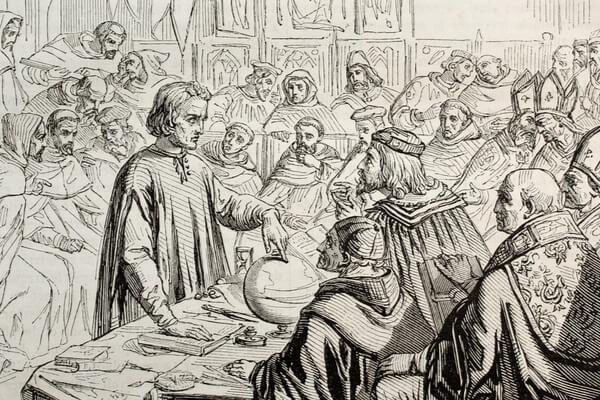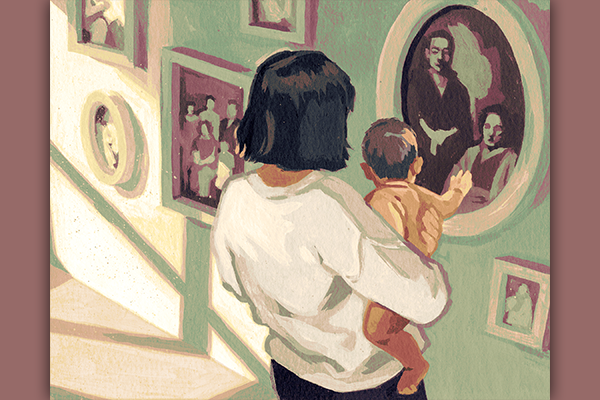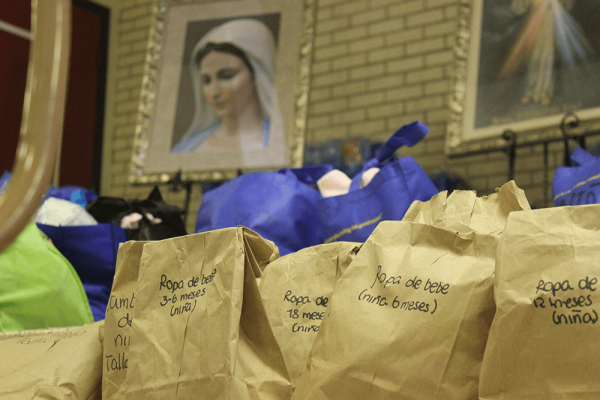“WHITE CHRISTIANITY IN America was born in heresy.”
This statement was made by Yale University theologian Eboni Marshall Turman last year before a large gathering of religion scholars. Marshall Turman, a formidable leader in African American theology, did not explain her meaning. In that room, she did not need to do so.
But as I heard her, I thought dolefully about how very long it took me as a white American Christian ethicist to be ready to engage or even to understand such a statement. I wondered doubtfully how many white American Christians today would be prepared to discuss it rationally. After all, part of what is so deeply wrong with white evangelicalism has to do with race. If what comes “after evangelicalism” does not address our racism at its roots, we shouldn’t bother.
To say that white Christianity in America was born in heresy is to make a theological statement about racism prior to any moral evaluation. It is to suggest that our local racism problem is ultimately rooted in heresy, a violation of central tenets of Christian doctrine. It is also to say that this heresy was present from the birth of American Christianity. There was no original innocence—the heresy and its resulting sins were there from the beginning.
This begs the question of whether the ultimate historical source of such heresy can be identified. It seems to me that a compelling starting point is 15th century Europe as it began conquering and colonizing the world in the name of Christ. The story begins with those first imperial powers, Spain and Portugal, but soon after extends to Britain and other European colonial nations, including Holland, France, Belgium, and so on. These were empire-building nations on the cusp of their grand adventures. They confidently believed themselves to be the center of the world, superior to all other cultures, entitled to conquer and colonize, and in doing so actively advancing God’s will. The European powers believed this for many centuries. Some would say that they, and their descendants, believe it still.
These European conquerors, and the church officials who blessed and authorized them, had 1,400 years in which to learn key elements of Christian theology that might have affected their plans. Three of the most relevant include the doctrine that all humans are made in the image of God and thus of equal worth to God (Genesis 1:26-27), the doctrine that all human beings are kin as all are descendants from Adam and Eve (Genesis 2:4-25, 3:20), and the doctrine that God is the author of moral law, which includes universal bans on murder, adultery, theft, and covetousness (Exodus 20:1-17).
But the European imperial powers decided to believe heresies instead. They believed in the unequal worth and value of, and in ontological differences between, persons based on their “race” and “color,” and they came to believe that God’s moral law against murder, adultery, theft, and covetousness did not apply in the relation between European conquerors and those they conquered.
Christian faith taught that people should be humble, aware of their mortality, sinfulness, and dependence on God. But the European conquerors instead succumbed to the deadly sin of pride. They were the best people on earth, the most advanced, the agents of civilization, the bearers of faith. Their church told them that they had the right and duty to conquer, colonize, extract, and even enslave entire non-European populations. As Willie Jennings has put it, these Europeans developed a “diseased social imagination.” It infected the entire world.
Christian faith should have served as a brake both on this pride and the wicked behaviors that it spawned. But Christianity had long since been fatally compromised by nationalism and proximity to political power. Rather than speaking with the prophetic voice of an Isaiah, or Jesus, European Christianity became a cheerleader for colonial conquest and enslavement, in the name of Jesus.
One could possibly imagine an imperialist, conquering, enslaving world power that is not also racist. But I cannot recall having ever read about one. Certainly, the 15th century European imperial mind racialized and colorized its prideful vision. It wasn’t just that colonial Europeans were better because they were Christian, more technologically advanced, and militarily superior. They were also better because they were persons of the “race” and “color” called “white,” by contrast with lesser persons of other colors and races. The terms get scare quotes because they are all social constructions. But their effects are real enough.
There were many pivotal moments in the racializing and colorizing of the European Christian mind. Certainly, the direct encounter between light-skinned Europeans and darker-skinned peoples whom they conquered and enslaved played a significant role. We were white and Christian and European and better; they were “red” and “brown” and “black,” and heathen and native and worse. We were normal humans, or peak humans, and they were less-than-that humans. We were entitled to rule. They were slated to suffer, serve, and die. All of this with God’s supervision and blessing.
The single best term to describe this kind of vision is white supremacism. Whiteness confers supremacy. And that, even a child in Sunday school ought to be able to tell you, is nothing but heresy. Yet it came to dominate the European and colonial mind.
An anthropology of rejection
I DO SUSPECT that theologian J. Kameron Carter is right that the ultimate origin of a racialized European Christian mind is traceable to historic Christian anti-Judaism. Born from biblical Judaism, born as a messianic-apocalyptic Jewish movement, in its childhood a diaspora Jewish-Gentile Christian movement, the church gradually became a largely Gentile community that structured theological anti-Judaism into its teachings. All it took was for this theology of rejection to become an anthropology of rejection based on “race” or even “blood.” Once having learned how to classify and reject a people based on race and blood, the paradigm was available for other uses.
The racializing of Christian anti-Judaism occurred in mid-15th century Spain. Jews that had been forcibly converted to Catholicism beginning in the late 14th century (called conversos), and their descendants, were sometimes suspected of still secretly practicing Judaism and not being true Catholics. Eventually the nobility decided that limpieza de sangre, “cleanliness of blood” or “blood purity,” should become employed as a status marker to delineate between the so-called “Old Christians” and “New Christians” such as these. This was a way to discriminate using a blood purity test even if true religious sentiments could not be divined. This racializing of anti-Judaism (also employed against Muslims in Spain) was a fateful move that ever after was available for deployment.
The bottom line is that over many centuries white Europeans and their colonial offspring developed what theologian Reggie Williams calls a racialized humanity, and inevitably a racialized divinity as well. In technical terms, both theological anthropology and Christology were compromised by heresy.
Despite the biblical texts to the contrary, humanity was now viewed not as one, but as many. Human diversity is real. But a human racial hierarchy is fictional, indeed, heretical. That is what white Europeans built: a perverted anthropology in which white people occupy the peak of the hierarchy, the highest in goodness and value. Then down it goes from there. The darker the body of the person, the lesser the value. Black bodies, especially, became associated with sin, pollution, and degradation. Racism specifically as anti-Blackness got written into Christian theology and practice.
God, and Jesus, became white too. God’s whiteness was seen not just in art, though white God/Jesus was common in stained glass and painting. Jesus, as the best and highest of human beings, became a white man in the white imagination. This was white racist Europe making a god in our own image. In biblical terms, when people create gods in their own image that is called idolatry. Jesus as white, as our white guy, our white Savior, our white God—this became taken for granted. You might not notice it until someone challenged it with a different image.
The deformation of Christianity
THE PORTUGUESE BEGAN enslaving Africans in the mid-15th century. More than 150 years later, the 20 or so Africans who arrived in the new Jamestown settlement were treated as indentured servants, as were some white Europeans. But over the succeeding decades, only African servitude became chattel slavery, with slave status inheritable. This development is highly significant, because it showed that anti-Black racism was required to institutionalize a mass system of chattel slavery. Somehow, white bodies could not be enslaved en masse and forever, but Black bodies could be. White supremacist heresy began to bear its sinful fruit on our soil.
Most human beings need to believe that what they are doing is morally justifiable. I think this very much helps to account for what developed in slaveholding America. White European racism before 1619 was sufficiently strong to help people justify the beginnings of African slavery. But the growing practice of African slavery here after 1619, with all its intrinsic and visible moral wrongs, required an intensification of white racism. It also required an intentional deformation of other aspects of Christian belief and practice so that Christian people could accommodate themselves to slavery. Christianity would need to be made amenable to building a state on the backs of Black slaves.
There were plenty of motivations to maintain slavery. The economy of an entire region gradually depended upon it. The most powerful people in the South built their lives, prosperity, families, and culture upon slavery. Financial interests well outside the South also benefited from the profits derived from slavery. Slavery was wired into the arrangements concluded in Philadelphia in 1776 and then in the Constitution in 1789. The shape of American politics from the beginning was affected by slavery.
But we still had a choice. Despite it all, we could have followed the British lead and abolished slavery. Instead, we deepened our excuses, weakened our ethics, and denied biblical theology.
From the very beginning, there were already voices proclaiming that slavery was sin— including but not limited to Black people who protested it. Honor goes to those like the Quakers who opposed slavery quite early. Somewhere deep inside themselves, many white Americans, including direct participants in the slave system, knew that what they were doing was sin. But they went on doing it.
A slaveholding empire run by Christians
IN ROMANS 1:18-32, Paul attempts to account for the moral chaos and degradation of humanity. His argument begins with the claim that all human beings have plenty of access to knowledge about God and morality because God has plainly revealed it. But “ungodliness and wickedness” flourish when people “in their wickedness suppress the truth” (Romans 1:18). Paul is saying that people actively suppress the truth “in their wickedness”—as an expression of their wickedness, and to enable further wickedness.
Paul argues that, as a result, “God gave them up to a debased mind and to things that should not be done. They were filled with every kind of wickedness” (Romans 1:28-29a). The suggestion is that God sometimes punishes people by allowing them to spiral downward, reap what they sow, and sink into ever greater debasement. The result is “every kind of wickedness,” including “covetousness, malice ... murder, strife, deceit, craftiness ... [and] slander”; as a way of life in which people feel free to be “insolent, haughty, boastful, inventors of evil ... foolish, faithless, heartless, ruthless” (Romans 1:29-31).
Paul could almost be describing a way of life in which, coveting ever-greater wealth and filled with pride in their own superior value, people set up a heartless, ruthless slave system in which they are free to covet, buy, sell, rape, steal, enslave, abuse, slander, deceive, and murder people—i.e., a slave state.
That similarity may not be coincidental. Paul was writing to Christian communities in Rome. Let us not forget that Rome was the capital of a massive slaveholding empire. Rome’s new Christians included many slaves and former slaves, who knew all too well the degradations of slavery.
The difference is that the Roman slaveholding empire was pagan. The colonial and Southern U.S. slaveholding empire was largely run by Christians. The first who made me see a connection between European colonialism and Romans 1:18-32 was the Spanish colonial cleric Bartolomé de Las Casas, who made the point explicitly in describing the horrors he witnessed. He saw firsthand that expression of absolute power over others, that spiral downward into ever crueler forms of torture and ever more wicked forms of evil.
So it was that the moral degradation sunk in deeply and spiraled fiercely, all while white slaveholding Christians found a way to live with themselves. This begins to communicate why Turman could say that white American Christianity was born in heresy.
This article is adapted with permission from After Evangelicalism: The Path to a New Christianity (Westminster John Knox, August 2020).

Got something to say about what you're reading? We value your feedback!







